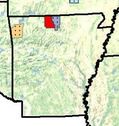 After detecting the fungus that causes white nose syndrome, but not seeing any bats with the disease, for two winters in a row, dead bats showing the symptoms caused by the white nose syndrome fungus were found in an Arkansas cave on January 11, an Arkansas Game and Fish Commission (AGFC) press release says.
After detecting the fungus that causes white nose syndrome, but not seeing any bats with the disease, for two winters in a row, dead bats showing the symptoms caused by the white nose syndrome fungus were found in an Arkansas cave on January 11, an Arkansas Game and Fish Commission (AGFC) press release says.
A total of five dead bats were found during a survey of the Marion County cave. Two of the bats were collected and submitted to the U.S. Geological Survey National Wildlife Health Center where it was confirmed that both bats had the fungus. Both bats had damage to wing, ear and tail membranes consistent with white-nose syndrome, the press release says.
This makes Arkansas the 23rd state to confirm white nose syndrome in bats.
Read the AGFC press release on the US Fish and Wildlife Service’s white nose syndrome web page. (The release was not on the AGFC website when this item was posted.)
Press reports have merely reprinted the press release. See an example here.
See State Wildlife Research News‘ coverage of this past summer’s fungus discovery in Arkansas, here.
Map by Cal Butchkoski, PA Game Commission, used courtesy US Fish and Wildlife Service. This year’s findings are in red.

 Fifteen native birds, plants and other animals have been removed from Wisconsin’s endangered and threatened species list effective Jan. 1, 2014, says a
Fifteen native birds, plants and other animals have been removed from Wisconsin’s endangered and threatened species list effective Jan. 1, 2014, says a  Has reviewing wind power project siting proposals become part of your department’s responsibilities? The US Fish and Wildlife Service (USFWS) is holding a training on Weds., Jan. 29. Other broadcasts in the series cover other aspects of wind turbine siting. Here’s the announcement from USFWS:
Has reviewing wind power project siting proposals become part of your department’s responsibilities? The US Fish and Wildlife Service (USFWS) is holding a training on Weds., Jan. 29. Other broadcasts in the series cover other aspects of wind turbine siting. Here’s the announcement from USFWS: Sorry for the double dose of white nose syndrome (WNS) news, but I didn’t want this to get lost in yesterday’s post on the the new WNS protocol, even though it was included in the same
Sorry for the double dose of white nose syndrome (WNS) news, but I didn’t want this to get lost in yesterday’s post on the the new WNS protocol, even though it was included in the same  The National Wildlife Health Center (in Madison, Wisc., part of the US Geological Survey) has updated the Bat Submission Guidelines for the 2013/2014 white nose syndrome (WNS) surveillance season.These are the protocols that you, a state wildlife biologist, would use to submit a bat or other sample to the center for WNS diagnosis.
The National Wildlife Health Center (in Madison, Wisc., part of the US Geological Survey) has updated the Bat Submission Guidelines for the 2013/2014 white nose syndrome (WNS) surveillance season.These are the protocols that you, a state wildlife biologist, would use to submit a bat or other sample to the center for WNS diagnosis. Between January 20 and February 2, 2014, the New Hampshire Department of Fish and Game will be collaring moose in the northern part of the state to study moose decline,
Between January 20 and February 2, 2014, the New Hampshire Department of Fish and Game will be collaring moose in the northern part of the state to study moose decline, It all began, says
It all began, says